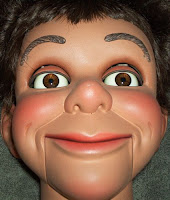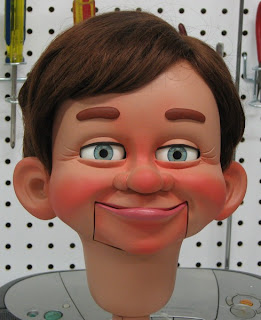Core Cast Urethane Heads. What does that even mean?!? It means a highly specialized mold that forms the outside and the inside at the same time when a head is cast in urethane. Advantages? Strength/Quality of the casting (which is very important to me) and ease of use when building a figure. We'll talk about these in a moment. Another reason for going this route?. . .
Being the first kid on the block to have a professional rotocasting machine (1998).......
... I experimented early on with rotocasting heads, figuring it would be a quick and easy way to cast quality heads (it can be if done correctly). But it had its downsides. Unusually thick spots, paper thin spots, and large bubbles or voids in places you don't want them. All such defects are a sign of inexperience with rotocasting, and require some skill and a bit of experience to overcome.
I don't know about anyone else, but I'm not a big fan of repairing a newly made head casting first thing. Also, when there are paper thin spots, this is a weak area in the casting. If a head takes a good hit or a fall, that is where it will break.
Urethane gets its strength from having the proper thickness (minimum 1/8" - 3/16" thick). Paper thin areas can be about as brittle as a soda cracker. Sure, you can patch it up with some epoxy putty, but it is very easy to make a 'marginal' bond (the repair can pop off of there) if not done correctly, and if so, that area is still fragile and susceptible to breakage. The repair may look like it is strong, but is it? Do some *destructive* testing to be sure.
Is there a better, more consistent process? Yes! Enter Core Cast urethane heads. Below is a photo of a core cast head..........
 |
| Core Cast Urethane Head with proper thickness throughout |
I knew there was a better way. When I cast a head using a core cast mold, it is a stronger casting right off the bat, as there ARE NOT ANY too thick or paper thin spots anywhere. No whopping bubbles. I have full control of how thick the casting is throughout.
If you look inside the head and hold it up against a light, you can readily see there are no thin spots in it. No defects to repair! Try that with an improperly rotocast head. You will have an *a-ha* moment!
What's the other reason I core cast my urethane heads? Simple answer. Ease of use. The eye and mouth areas are already cut out, the trap door is already cut out, little if any fitting of the jaw, and the control stick hole is already done.......
That's only part of the picture. Then there are the advantages on the inside.....
There are flanges built into the casting for the jaw pivot rod. I don't have to guess where the rod needs to go, and the flanges provide a rock-solid area to glue to with no worry about a marginal epoxy putty bond failing (if not done correctly, they surely can fail). The eye tray flanges also provide a very secure area to glue to.
Besides peace of mind, these features save a TON of time. I am one of the few full time figure makers out there. How long it takes to build a figure is key to being successful and eating regularly! (grin) I did it the hard way for a number of years, but got very tired of repeatedly cutting, drilling, fitting, etc., when it just didn't have to be that way.
Why don't a lot of others do core cast urethane? There are few mold makers, let alone figure makers that know how to do this. It is a complex mold, and took some 37 years of mold making experience (47 years now) to figure out my exact process. I've got it down to a science now, as they say. If it were an easy thing to do, everyone would be doing it.
Sorry its been so long between posts, but it is very busy here, and I'm juggling quite a bit at the moment. Its a good thing I know how to juggle......


















































